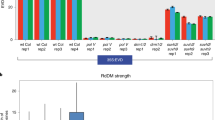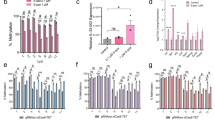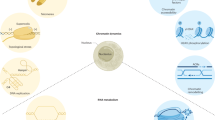Abstract
Double-stranded RNA molecules targeted to gene promoter regions can induce transcriptional gene silencing in a DNA cytosine methylation–dependent manner in plants (RNA-dependent DNA methylation)1,2,3. Whether a similar mechanism exists in mammalian systems is a vital and controversial issue4,5,6. DNA methylation is an important component in mammalian gene silencing for normal processes such as gene imprinting and X-chromosome inactivation7,8,9, and aberrant CpG island hypermethylation at tumor-suppressor promoters is associated with transcriptional silencing and loss of gene function in cancer10. Hence, we investigated whether RNA-dependent DNA methylation might operate in human cancers to mediate epigenetic silencing using the endogenous gene CDH1 as a potential target. The loss of this cell-cell adhesion factor facilitates the metastatic process, and its promoter is frequently hypermethylated in breast and other cancers11,12,13. We found that, although small double-stranded RNAs targeted exclusively to the CDH1 promoter could effectively induce transcriptional repression with chromatin changes characteristic of inactive promoters, this was entirely independent of DNA methylation. Moreover, we could accomplish such silencing in a cancer cell line genetically modified to lack virtually any capacity to methylate DNA.
This is a preview of subscription content, access via your institution
Access options
Subscribe to this journal
Receive 12 print issues and online access
$209.00 per year
only $17.42 per issue
Buy this article
- Purchase on SpringerLink
- Instant access to full article PDF
Prices may be subject to local taxes which are calculated during checkout




Similar content being viewed by others
References
Wassenegger, M., Heimes, S., Riedel, L. & Sanger, H.L. RNA-directed de novo methylation of genomic sequences in plants. Cell 76, 567–576 (1994).
Pelissier, T., Thalmeir, S., Kempe, D., Sanger, H.L. & Wassenegger, M. Heavy de novo methylation at symmetrical and non-symmetrical sites is a hallmark of RNA-directed DNA methylation. Nucleic Acids Res. 27, 1625–1634 (1999).
Wassenegger, M. RNA-directed DNA methylation. Plant Mol. Biol. 43, 203–220 (2000).
Kawasaki, H. & Taira, K. Induction of DNA methylation and gene silencing by short interfering RNAs in human cells. Nature 431, 211–217 (2004).
Morris, K.V., Chan, S.W., Jacobsen, S.E. & Looney, D.J. Small interfering RNA-induced transcriptional gene silencing in human cells. Science 305, 1289–1292 (2004).
Park, C.W., Chen, Z., Kren, B.T. & Steer, C.J. Double-stranded siRNA targeted to the huntingtin gene does not induce DNA methylation. Biochem. Biophys. Res. Commun. 323, 275–280 (2004).
Plath, K., Mlynarczyk-Evans, S., Nusinow, D.A. & Panning, B. Xist RNA and the mechanism of X chromosome inactivation. Annu. Rev. Genet. 36, 233–278 (2002).
Reik, W. & Walter, J. Genomic imprinting: parental influence on the genome. Nat. Rev. Genet. 2, 21–32 (2001).
Reik, W., Collick, A., Norris, M.L., Barton, S.C. & Surani, M.A. Genomic imprinting determines methylation of parental alleles in transgenic mice. Nature 328, 248–251 (1987).
Jones, P.A. & Baylin, S.B. The fundamental role of epigenetic events in cancer. Nat. Rev. Genet. 3, 415–428 (2002).
Graff, J.R., Herman, J.G., Myohanen, S., Baylin, S.B. & Vertino, P.M. Mapping patterns of CpG island methylation in normal and neoplastic cells implicates both upstream and downstream regions in de novo methylation. J. Biol. Chem. 272, 22322–22329 (1997).
Graff, J.R. et al. E-cadherin expression is silenced by DNA hypermethylation in human breast and prostate carcinomas. Cancer Res. 55, 5195–5199 (1995).
Hiraguri, S. et al. Mechanisms of inactivation of E-cadherin in breast cancer cell lines. Cancer Res. 58, 1972–1977 (1998).
Herman, J.G., Graff, J.R., Myohanen, S., Nelkin, B.D. & Baylin, S.B. Methylation-specific PCR: a novel PCR assay for methylation status of CpG islands. Proc. Natl. Acad. Sci. USA 93, 9821–9826 (1996).
Matzke, M. et al. Genetic analysis of RNA-mediated transcriptional gene silencing. Biochim. Biophys. Acta 1677, 129–141 (2004).
Kanno, T. et al. Involvement of putative SNF2 chromatin remodeling protein DRD1 in RNA-directed DNA methylation. Curr. Biol. 14, 801–805 (2004).
Aufsatz, W., Mette, M.F., van der Winden, J., Matzke, M. & Matzke, A.J. HDA6, a putative histone deacetylase needed to enhance DNA methylation induced by double-stranded RNA. EMBO J. 21, 6832–6841 (2002).
Mette, M.F., Aufsatz, W., van der Winden, J., Matzke, M.A. & Matzke, A.J. Transcriptional silencing and promoter methylation triggered by double-stranded RNA. EMBO J. 19, 5194–5201 (2000).
Jeddeloh, J.A., Stokes, T.L. & Richards, E.J. Maintenance of genomic methylation requires a SWI2/SNF2-like protein. Nat. Genet. 22, 94–97 (1999).
Nan, X. et al. Transcriptional repression by the methyl-CpG-binding protein MeCP2 involves a histone deacetylase complex. Nature 393, 386–389 (1998).
Heard, E. et al. Methylation of histone H3 at Lys-9 is an early mark on the X chromosome during X inactivation. Cell 107, 727–738 (2001).
Nakayama, J., Rice, J.C., Strahl, B.D., Allis, C.D. & Grewal, S.I. Role of histone H3 lysine 9 methylation in epigenetic control of heterochromatin assembly. Science 292, 110–113 (2001).
Rhee, I. et al. DNMT1 and DNMT3b cooperate to silence genes in human cancer cells. Nature 416, 552–556 (2002).
Schmelz, K. et al. Induction of gene expression by 5-Aza-2'-deoxycytidine in acute myeloid leukemia (AML) and myelodysplastic syndrome (MDS) but not epithelial cells by DNA-methylation-dependent and -independent mechanisms. Leukemia 19, 103–111 (2005).
Schramke, V. & Allshire, R. Hairpin RNAs and retrotransposon LTRs effect RNAi and chromatin-based gene silencing. Science 301, 1069–1074 (2003).
Volpe, T. et al. RNA interference is required for normal centromere function in fission yeast. Chromosome Res. 11, 137–146 (2003).
Volpe, T.A. et al. Regulation of heterochromatic silencing and histone H3 lysine-9 methylation by RNAi. Science 297, 1833–1837 (2002).
Cao, X. et al. Role of the DRM and CMT3 methyltransferases in RNA-directed DNA methylation. Curr. Biol. 13, 2212–2217 (2003).
Aufsatz, W., Mette, M.F., Matzke, A.J. & Matzke, M. The role of MET1 in RNA-directed de novo and maintenance methylation of CG dinucleotides. Plant Mol. Biol. 54, 793–804 (2004).
Frommer, M. et al. A genomic sequencing protocol that yields a positive display of 5-methylcytosine residues in individual DNA strands. Proc. Natl. Acad. Sci. USA 89, 1827–1831 (1992).
Acknowledgements
We thank B. Lee for suggestions, support and critical reading of the manuscript and T. Jenuwein for providing the antibodies to H3K9me2 used in the ChIP assay. This work was supported by a grant from the US National Institutes of Health.
Author information
Authors and Affiliations
Corresponding author
Ethics declarations
Competing interests
The authors declare no competing financial interests.
Supplementary information
Supplementary Fig. 1
Real time ChIP analyses of hMLH1 promoter in HCT116 cells. (PDF 73 kb)
Supplementary Table 1
Sequences of dsRNA oligonucleotides and PCR primers. (PDF 18 kb)
Rights and permissions
About this article
Cite this article
Ting, A., Schuebel, K., Herman, J. et al. Short double-stranded RNA induces transcriptional gene silencing in human cancer cells in the absence of DNA methylation. Nat Genet 37, 906–910 (2005). https://doi.org/10.1038/ng1611
Received:
Accepted:
Published:
Issue Date:
DOI: https://doi.org/10.1038/ng1611
This article is cited by
-
Targeted drug delivery strategies for precision medicines
Nature Reviews Materials (2021)
-
The current state and future directions of RNAi-based therapeutics
Nature Reviews Drug Discovery (2019)
-
Nuclear functions of mammalian MicroRNAs in gene regulation, immunity and cancer
Molecular Cancer (2018)
-
Functional characterization of a multi-cancer risk locus on chr5p15.33 reveals regulation of TERT by ZNF148
Nature Communications (2017)
-
Transcriptional silencing of long noncoding RNA GNG12-AS1 uncouples its transcriptional and product-related functions
Nature Communications (2016)



